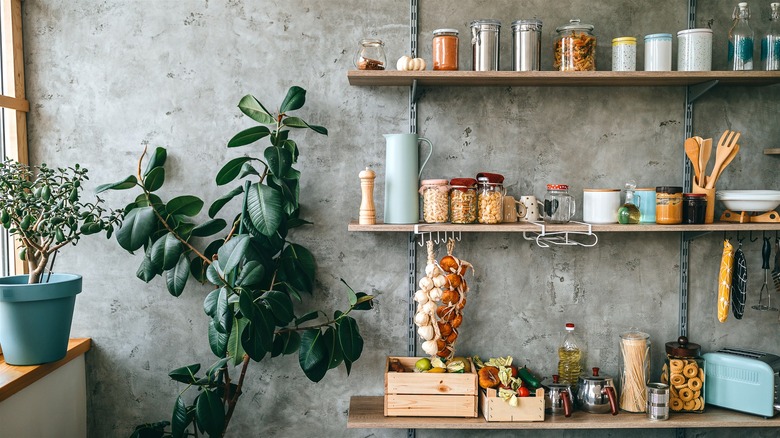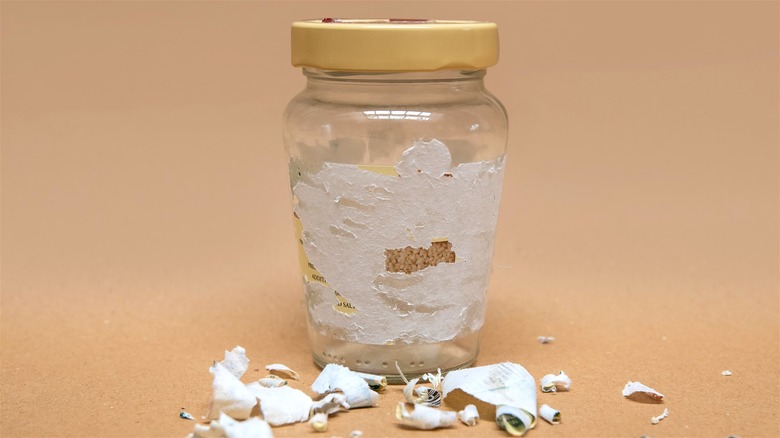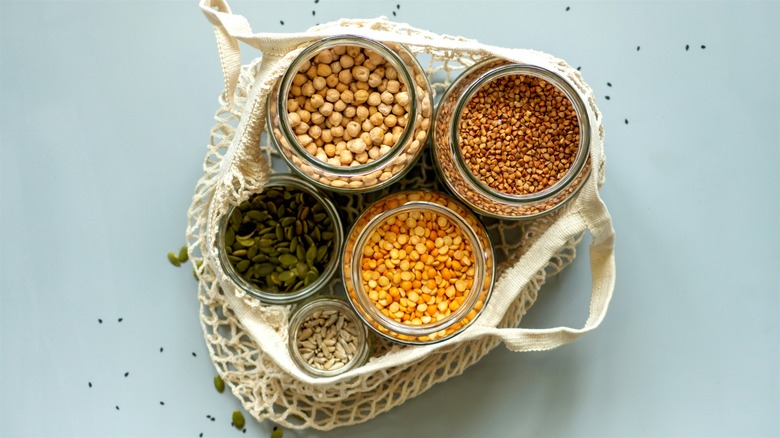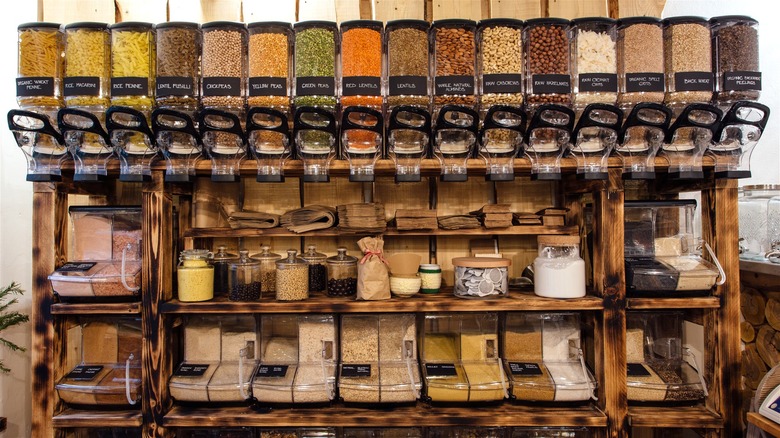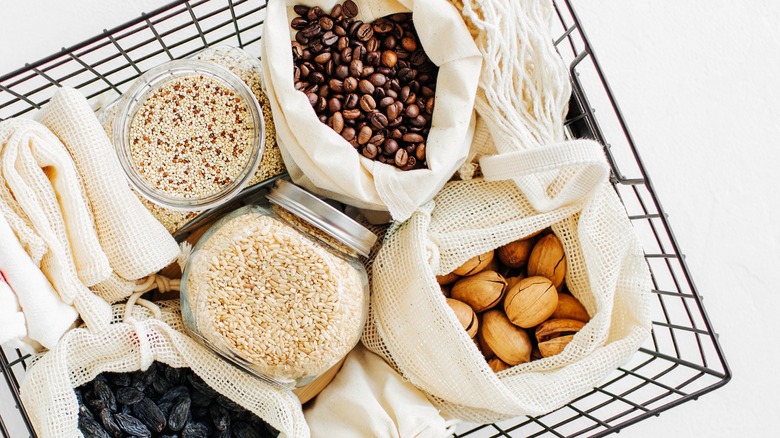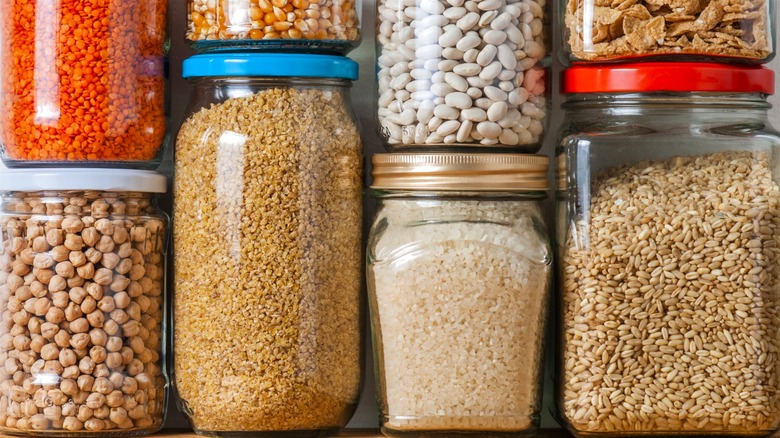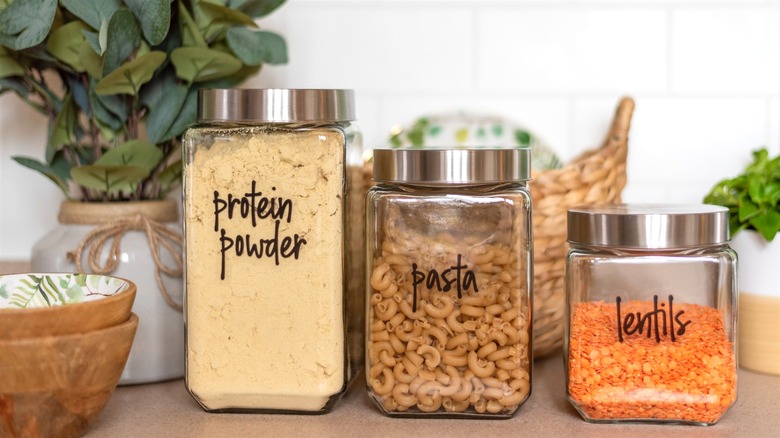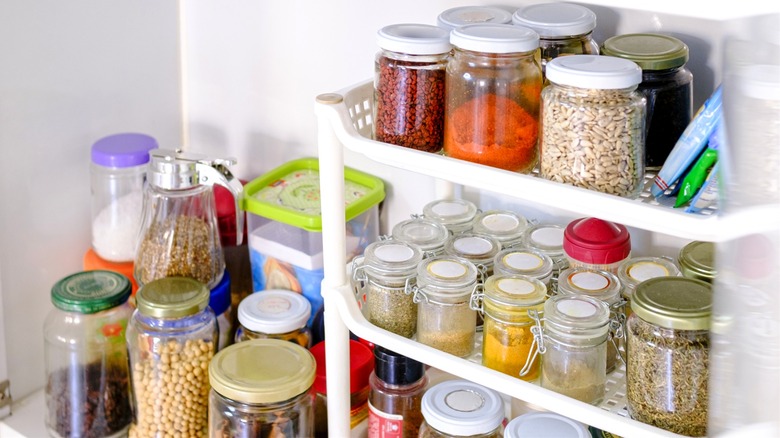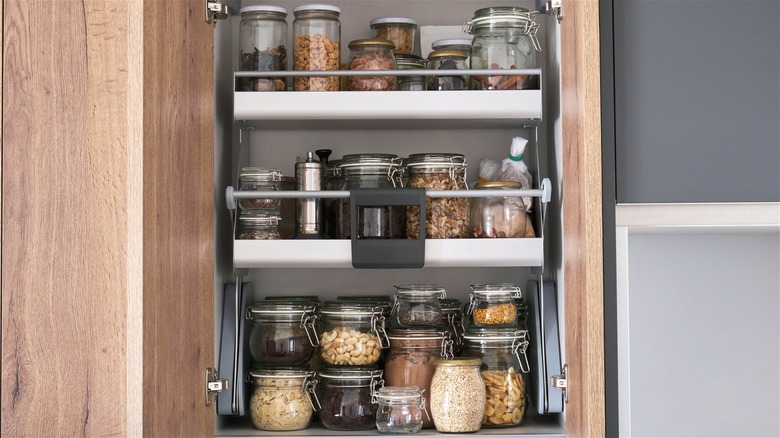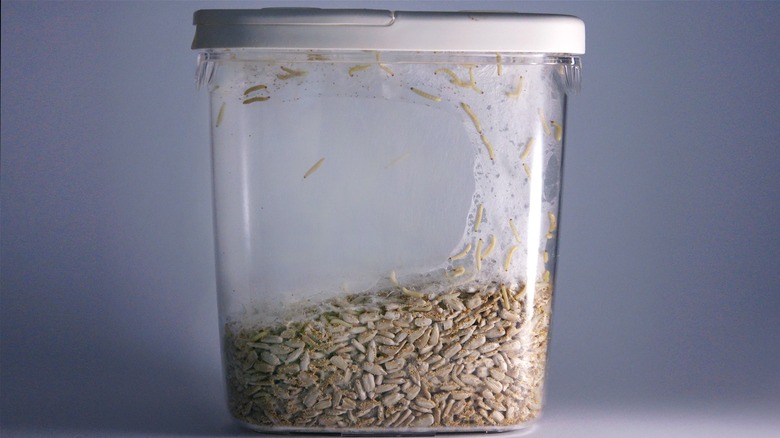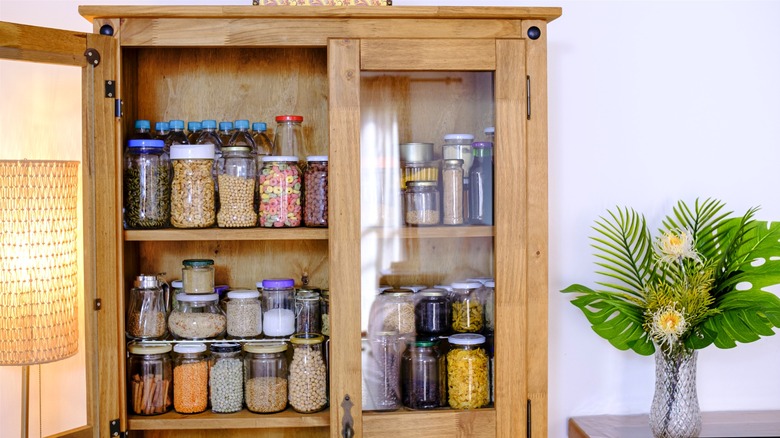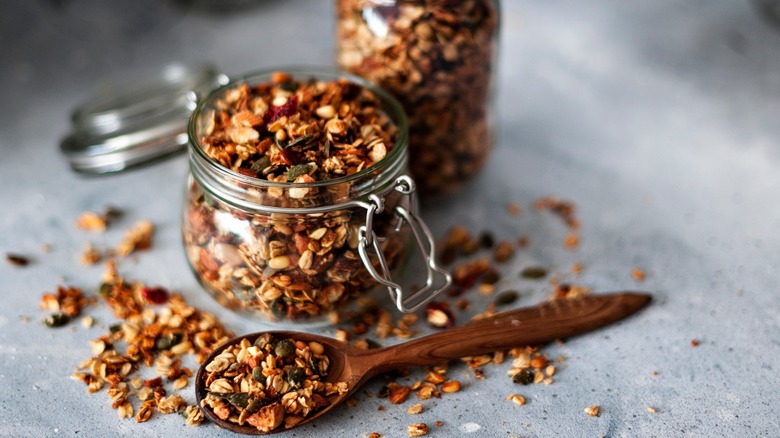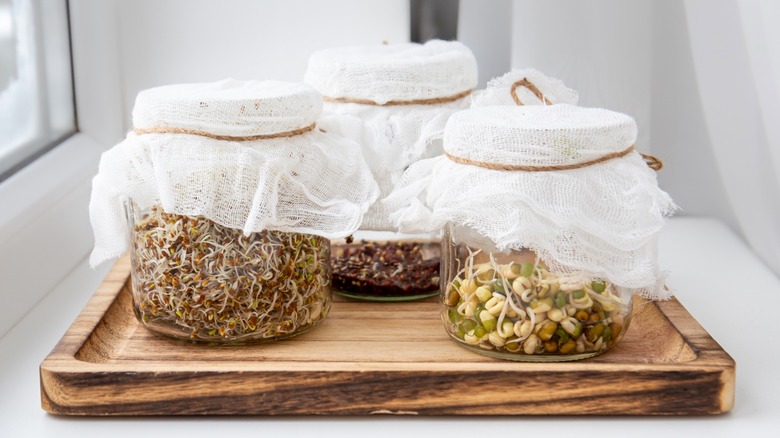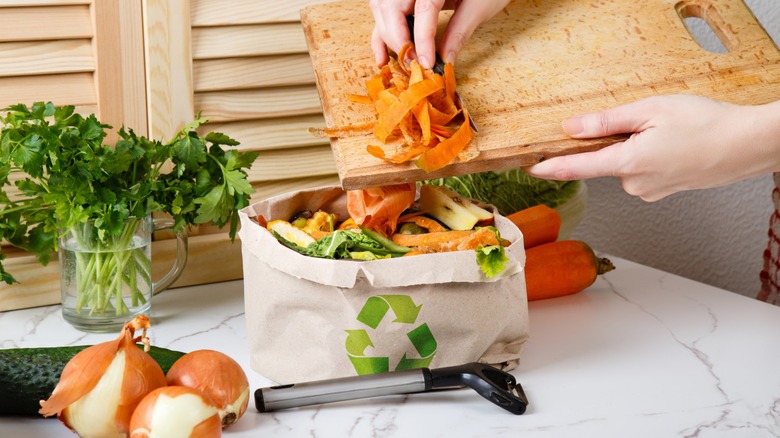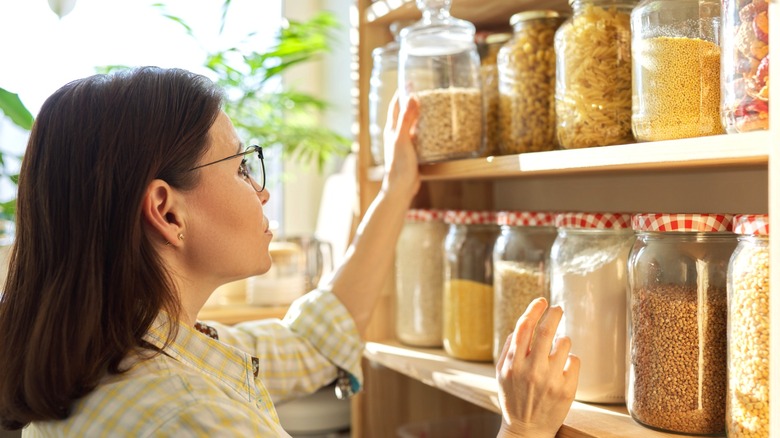15 Tips For Building A Low-Waste Pantry
A shift toward a more eco-friendly lifestyle might seem overwhelming, but it doesn't have to be. With food waste contributing a staggering 170 million metric tons of carbon dioxide equivalent annually, according to the EPA, it's clear that our kitchens need a low-waste revolution. A pantry built with low or zero-waste in mind might champion minimal plastic use and bulk shopping — your personal answer to combating environmental concerns. If saving the planet isn't your top priority, then consider the time and money you'll save by welcoming bulk principles into your life.
Make your pantry a testament to conscious choices, excellent organization, and well-thought-out storage. Your pantry staples can become culinary muses (without the grocery run). We'll help you explore the potential of upcycling food scraps or composting instead of adding to the landfill. Or craft your own staples, stripping away excess packaging and cutting costs. And, of course, plan ahead and bring your own reusable bags and containers for shopping. Read on to discover more ways to make a tangible impact, one zero-waste pantry at a time.
Start by decluttering your pantry
Cleaning out your pantry is a great place to start because it will allow you to assess your spending and storage habits. If you haven't done it in a while, prepare for some amazing discoveries. Removing every item from the pantry is akin to digging through a graveyard of your past self: the Dalgona coffee lover, the gluten-free baker, the superfood fiend — all will look back at you from half-used or never opened packages of instant coffee, almond flour, and spirulina powder. If any of your discoveries are well past their expiration date, toss them. Anything that's still edible but useless to you can be donated.
Take inventory of the remaining items, grouping them by type, and make a record of those you'll need to restock. Some foods, like nuts or cold-pressed oils, are foods that shouldn't stay in your pantry storage; you'll need to refrigerate them. Next, vacuum the empty shelves, and use some cleaning spray and a microfiber cloth to remove any remaining dust. Put everything back in a way that makes sense to you, and enjoy an organized pantry.
Upcycle containers you already own
If you think you need to get rid of everything you own that doesn't fit the aesthetic and spend hundreds of dollars on new food storage container sets, think again. There is no need to create more waste and make unnecessary purchases when you can shop around the house for your imperfectly perfect low-waste pantry. For example, a quick dig through your recycling bin can unearth jars that you can use for storage. Soaking them in hot water with vinegar, then scrubbing them with a baking soda and oil paste, will help get even the most stubborn labels off.
While glass is considered a more sustainable option that is better suited for long-term storage, any food container with a tight-fitting lid is good enough in a pinch. Even takeout boxes can be reused. David Chang says you should avoid buying food storage containers, at all. But they won't last forever, and in any case, slowly eliminating plastic from your pantry should be the goal in the long run. So, when you're ready to add new containers or organizing tools, search thrift stores or Craigslist first.
Make a list of common pantry items
Aside from getting rid of what's no longer useable, the goal of decluttering your pantry is to determine which ingredients you already have and how often you use them. Ask yourself what makes the base of your home cooking, then make a shopping list accordingly. This can vary depending on the diet or lifestyle, but in general, you want to stock up on non-perishable whole foods, such as grains, legumes, and pasta, as well as a selection of basic oils, vinegar, and baking supplies. You can always add specialty items later, but start with the essentials.
Some cooks might want to add some unique vegan staple ingredients, such as textured vegetable protein, nutritional yeast, and black salt. But, whether you're vegan or not, filling your pantry with seasonings is a must. Anything from dried herbs and red pepper flakes to soy sauce and tahini will help take those pantry staples to the next level.
Finally, your pantry is also the perfect place to store onions, garlic, potatoes, and winter squashes. So if you take stocking it seriously, you can whip up delicious plant-based meals with what's on hand.
Explore bulk shopping options
Setting up a low-waste pantry means changing your shopping routine. The bad news is that it might take some time to research and get used to, and you might go through some initial discomfort, but that's absolutely normal. The good news is, you'll feel so much better about yourself, your eye-pleasing pantry, and your near-empty recycling bin in no time.
For starters, look up a state-by-state zero-waste grocery guide. Find a bulk store in your area or online; most are small businesses offering package-free products. Another option you can consider is visiting your nearby supermarkets to purchase items in bulk. Some supermarkets have dispensers for dry foods, while others provide bins of beans and pasta for you to fill your reusable bags with.
However, there are some non-perishable foods you need to think twice about buying in bulk. Dried spices, breadcrumbs, coffee, baking powder, almond flour, and cooking oil are some of them. They all lose their flavor or potency with time. Since you're not likely to go through large amounts of these ingredients quickly, it's best to apply a "less is more" mindset when shopping.
Shop package-free
Single-use plastic bags are slowly getting out of fashion, with most states issuing a ban on them and large retailers like Walmart eliminating them from their stores and offering reusable alternatives. If you're new to the concept of plastic-free shopping, you may end up with more reusable bags than you need, as it takes practice to remember to carry one around. However, you can always keep a couple with you by storing them in your car and in various places around your home.
But it's not just the big carryout bags that you'll want to incorporate into your grocery shopping routine. Reusing clean paper lunch bags or jars is a no-brainer. Zip-top plastic bags can and should be reused. Although they're typically reserved for leftovers, you can use them for buying grains, nuts, or other lightweight pantry staples. But it might be even better to invest in a set of reusable silicone bags as they're more durable and food-safe. Finally, you can make some eco-friendly produce bags yourself or find them at your nearest zero-waste store. Ideally, they should be made from linen or cotton, not nylon.
Develop a decanting habit
Decanting is a term wine drinkers are likely familiar with, but it has a whole new meaning when it comes to food. It sounds fancy, but in practice, it just means transferring foods from their original packaging to designated clear containers. And if you're not using this trick to organize your pantry, you're doing it wrong. Decanting is not just aesthetically pleasing; it allows you to store products more efficiently. For example, it's easier to notice when you're running low on beans or if bugs have contaminated your flour.
However, not everyone is a fan of decanting. Some experts find TikTok's food-organizing trend problematic because of how time-consuming, costly, and unsustainable decanting can be. But it's important to recognize that everyone's situation is unique. For example, if you live alone, work remotely, prioritize sustainability, or all of the above, you may have the time and dedication to reuse jars from other products instead of purchasing a fancy set of Insta-worthy containers.
Even Stanley Tucci uses mason jars! Additionally, some stores allow you to bring your own containers for shopping, eliminating the need to transfer items once you return home and saving you time.
Label storage containers sustainably
It's critical to create a system to remember what's in each container in your pantry. Using green masking tape for labels as they do on "The Bear" might be enticing, but if you're striving for sustainability, opt for an erasable chalk marker to scribble directly on the jar or Tupperware. Another eco-conscious alternative is to purchase a set of biodegradable, compostable labels that could even be customized to your liking. If you're planning on buying a whole new set of storage containers, consider ones pre-labeled with typical pantry and spice names, saving you the chore of handwriting the labels.
Beyond labeling the contents, it's wise to note essential dates: purchase date (especially for package-free items), expiration date, and possibly the cooking instructions originally on the packaging. And don't let those "best by" labels fool you. They're not expiration dates but literal suggestions of how long the product is best for consumption. This might feel like extra work, but it makes you more mindful about what you buy and how you store it and makes keeping track of everything easy.
Organize the pantry for everyday use
There's no point in having a beautiful and neat pantry if the way it's organized is not functional. First, arrange foods by category — no more digging around for baking supplies. Aim to position items as close to their point of use as possible, and keep the most frequently used ingredients at eye level. Don't forget the kitchen rotation trick to keep your pantry fresh: Keep older items at the front so they're used before newer ones.
Next, consider adding kitchen organizers, such as bins for your snacks and tiny items you don't decant. A few strategically placed lazy Susans will bring those hard-to-reach jars within a simple spin's reach. Chrome baskets are perfect for fresh produce, while a spice rack will keep your flavorings at the ready. You can also add some charm and function with hooks and hanging baskets.
Finally, if maximizing pantry space is your top priority, opt for stackable, square-shaped containers. Additionally, a couple of shelf risers will double or even triple your jar storage and help keep items at the front of the cabinet. Ultimately, how you organize your pantry should make restocking and cooking a breeze, not a painful chore.
Keep things fresh
Longevity is key when it comes to pantry staples. Hence, mastering the art of storage, even for the casual home cook, is vital to avoid food waste. For example, if you want to keep your yeast alive and well, store yeast in a resealable plastic bag or jar in the freezer. An airtight container is also the absolute best way to keep brown sugar soft and prevent clumping. And, of course, keeping your flour in one will ensure no bugs creep in — or you'll notice it quickly if they do.
Other pantry items that need to be kept in airtight containers include dried fruit, spices, grains, and legumes. If you don't have enough space or time to decant all of your dried foods, prioritize these ones. And for those items nearing their end and unlikely to be replenished soon, show them some love by transferring them to smaller airtight containers. This simple act minimizes air exposure and optimizes pantry space.
Practice pest prevention
There is nothing more upsetting than having a pest-infested pantry. Unfortunately, these critters can infiltrate your food at any stage, from production to your kitchen. So, don't beat yourself up if you miss the early signs. However, it doesn't hurt to be vigilant: check under products on grocery store shelves, as well as inside the bags, to see any signs of life. If you're a bulk buyer, consider using smaller gravity-fed dispensers. They're a boon as they reduce food exposure and are refilled more frequently, keeping pests at bay.
Now, for those of us who detest food waste, the thought of tossing flour infested with weevils may be heartbreaking. Yes, weevil-infested flour is safe to eat, but the idea of nibbling on bugs isn't exactly appetizing, is it? Hence, prevention is key. How about using a bay leaf? Just pop bay leaves into your dry goods containers. It's an eco-friendly, non-toxic solution that won't transfer any aroma. Alternatively, a good wipe-down of pantry surfaces with peppermint oil also helps deter pests. Finally, buy in quantities you'll use within a few months, and before storing grains and seeds, freeze them for one to four days to exterminate any potential pests.
Shop your pantry when planning meals
Trying every recipe the Instagram algorithm is pushing on you is tempting. But, instead of shopping for one-time extravagant ingredients, unearth the culinary treasures hiding in plain sight. Embrace pantry-cleaning meals that can be whipped up when it seems like there's "nothing" at home.
Craft a rich, creamy hummus recipe from leftover chickpeas and tahini, or drizzle a sharp dijon vinaigrette over a humble potato salad to elevate it to gourmet status. Breathe new life into plain grains with a luscious swirl of canned coconut milk. Oil, onion, and garlic, the unassuming stalwarts of your pantry, can band together to deliver a delectable five-ingredient vegan risotto recipe. And if all you have is rice, a soothing bowl of plain congee won't let your hunger go unanswered. For a trendy twist, try your hand at pantry pasta made from canned staples.
Shopping from your pantry not only ensures a regular rotation of items, keeping staleness and food waste at bay, but also prevents overstuffing your shelves. So it's always better to check your pantry and fridge for inspiration before heading to the store.
Make your own pantry staples
If you have enough dedication to shift to a low-waste pantry, you might also be willing to carve out some time to make foods from scratch. That doesn't mean you need to replace all essentials with their homemade versions, but some foods are inherently better when prepared at home, either in terms of flavor and quality or in terms of price.
If your pantry is stocked with essentials such as flour, oats, sweeteners, condiments, and legumes, you can easily make granola, salad dressings, syrups, beans, nut butter, spice mixes, and more. Not only will it save you money, but it will also eliminate the need to buy them pre-packaged at the store.
Additionally, this way, you can stop throwing certain foods out. For example, to whip up a pickle juice vinaigrette, you'll need oil, vinegar, alliums, and a couple of spices mixed in with the leftover juice. Any stale bread can easily be turned into breadcrumbs, and a near-empty peanut butter or jam jar can be loaded with oats and plant milk for a nutritious overnight breakfast. The possibilities are endless!
Turn pantry items into microgreens
In the spirit of low-waste creativity, consider transforming those leftover seeds and legumes cluttering your pantry into a nutrient-rich, home-grown delight. You'll be surprised to learn that you can sprout almost anything — from lentils and beans to rice and buckwheat. For an aesthetic flourish, chia, broccoli, and alfalfa seeds can be coaxed into vibrant microgreens, perfect for providing a chic garnish for a springy pea salad recipe or any other dish.
To sprout seeds, you'll need a wide-mouth jar with a special sprouting lid or a linen-clad bowl and some patience. You'll need to rinse and dry the seeds three times a day for a few days before they're ready to eat.
We've all heard that eating bean sprouts can be risky. While they have a reputation for potential contamination, sprouting at home reduces these risks, provided you diligently follow the sprouting process. However, to err on the side of caution, consider cooking your home-grown sprouts until they are thoroughly heated. To maintain sprouts' freshness, store them submerged in ice water in the fridge and change the water daily. So, dust off those mason jars and embark on this sprouting adventure.
Compost whatever can't be reused
You can go to great lengths to minimize your food waste, but it's still going to be hard to eliminate it altogether. Fortunately, organic food matter is not trash — unless you send it to a landfill. Instead, you can turn it into fertilizer through composting. It's a great way to repurpose food scraps or expired products (except meat).
What's more, you can compost even if you live in an apartment: keep a designated bin in your kitchen or a bag for compostable scraps in the freezer, and once it's full, you have several options.Some cities offer curbside compost pickup services, and that's probably the easiest way to send it on its way.
Alternatively, you can turn composting into a community-building activity, reaching out to small businesses and local farmers to see if anyone's interested. If you want to dig deeper — literally — and create compost for personal use, you can look into various methods, including a worm bin (vermicomposting) to a higher-end anaerobic bucket required for the Bokashi method. Whichever option you choose, look for the tell-tale signs your compost is ready to use: an earthy smell and a crumbly texture.
Don't strive for perfection
Let's face it: Life isn't an airbrushed photo spread, and your pantry needn't be one either. The idea of maintaining a flawless zero-waste kitchen can seem daunting, if not entirely out of reach. But perfection shouldn't be your goal — mindfulness should. Accept that while your pantry may never be truly zero-waste, and your carbon footprint might not hit the mark, there are still substantial strides you can make toward sustainable living.
Step into the kitchen with a fresh perspective, ready to embrace the creative challenge. As chef Nick DiGiovanni suggests, every morsel in your pantry holds a potential culinary adventure. Upcycling food, or the practice of creating something edible out of what would otherwise be discarded, is also something you could implement into your routine. Be the change and inspire others to join the low-waste pantry revolution. Remember, it's not about perfection, but progress.
Static Media owns and operates Tasting Table and Mashed.
